Part 84 United States Drug Enforcement Administration Releases 2015 National Drug Threat Assessment Summary Cocaine, 4,944 cocaine related deaths, Mexican, Columbian, Peruvian, smuggling, crime. DEA ICE FDA
[2015 Drug Threat Assessment Continued from Part 83 Methamphetamine]
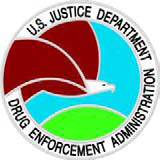
DEA Releases 2015 Drug Threat Assessment Cocaine
The US Drug Enforcement Administration 2015 National Drug Threat Assessment (NDTA) is a comprehensive report of the threat posed to the United States by the trafficking and abuse of illicit drugs, the nonmedical use of CPDs, [Controlled Prescription Drugs] , money laundering, TCOs [Transnational Criminal Organization] , gangs , smuggling, seizures, investigations, arrests, drug purity or potency, and drug prices, in order to provide the most accurate data possible to policymakers, law enforcement authorities, and intelligence officials.
Part 84 United States Drug Enforcement Administration Releases 2015 National Drug Threat Assessment Summary Cocaine, 4,944 cocaine-related deaths, Mexican, Columbian,Peru, smuggling, crime.
Cocaine Overview
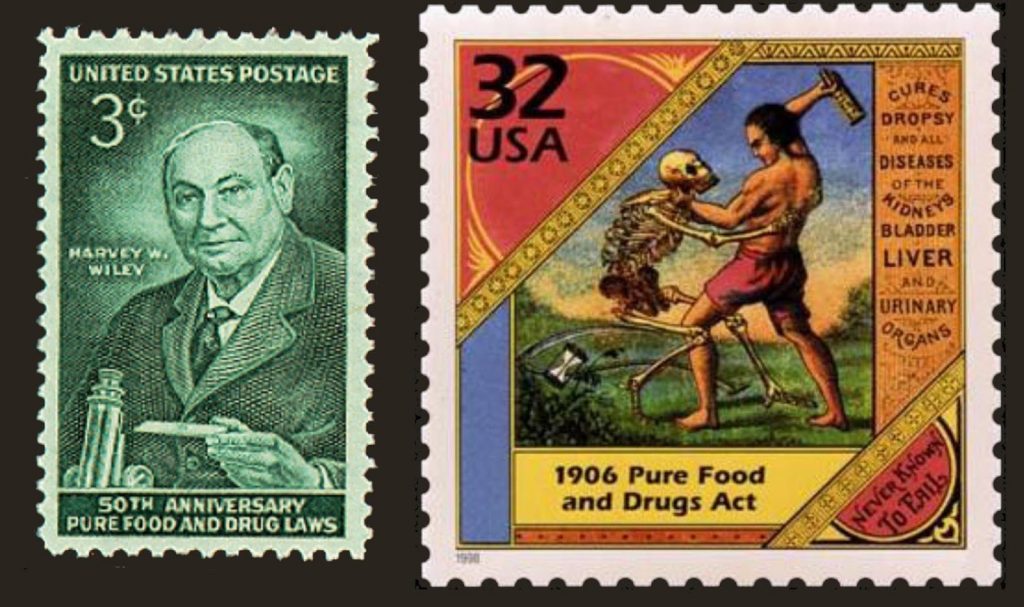
Cocaine availability in the United States appeared to have stabilized at “new normal” levels in 2014— still well below the availability levels observed prior to 2007, when cocaine availability first began to decline significantly. Use indicators also show a steady decline in cocaine use in the United States when compared to the previous 10 years. (See Chart 24.) Most of the cocaine smuggled into the United States is transported over the Southwest Border with a smaller percentage transported through the Caribbean corridor. Mexican TCOs continue to dominate the cocaine transportation infrastructure in the United States with little to no competition.
(U) Chart 24. Cocaine Indicators, based on 2006 Value, 2002 – 2013 Source: Office of National Drug Control Policy
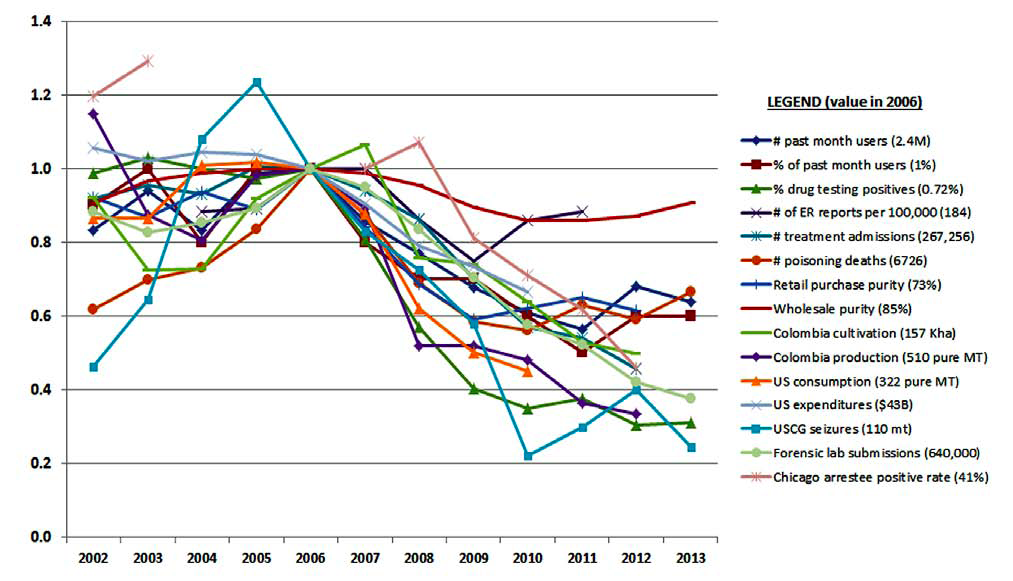
# of past month users (2.4M)
% of past month users (1%)
% drug testing positives (0.72%)
# of ER reports per 100,000 (184)
# treatment admissions (267,256)
# poisoning deaths (6726)
Retail purchase purity (73%)
Wholesale purity (85%)
Colombia cultivation (157 Kha)
Colombia production (510 pure MT)
US consumption (322 MT)
US expenditures ($43B)
USCG seizures (110m)
Forensic lab submissions (640,000)
Chicago arrestee positive rate (41%)
Availability [Cocaine]
The availability of cocaine in the United States remained at historically lower levels in 2014, but appears relatively stable when compared to the previous seven years, at what can be considered the “new normal.” The majority of DEA FDs in 2014 indicated cocaine availability was moderate in their area, meaning cocaine is accessible. Only two DEA FDs—Boston and Philadelphia—indicated that cocaine availability was high. Additionally, only 14.9 percent of 2015 NDTS respondents indicated high availability of cocaine with only 19.7 percent indicating the same for crack cocaine. (See Maps 9 and 10.) Cocaine no longer saturates the US drug market as it did previous to 2007, but still poses a significant threat in the United States.
(U) Map 9. Percentage of NDTS Respondents Reporting High Powder Cocaine Availability, 2008 – 2011, 2013 – 2015 11, 2013 – 2015. Source: National Drug Threat Survey
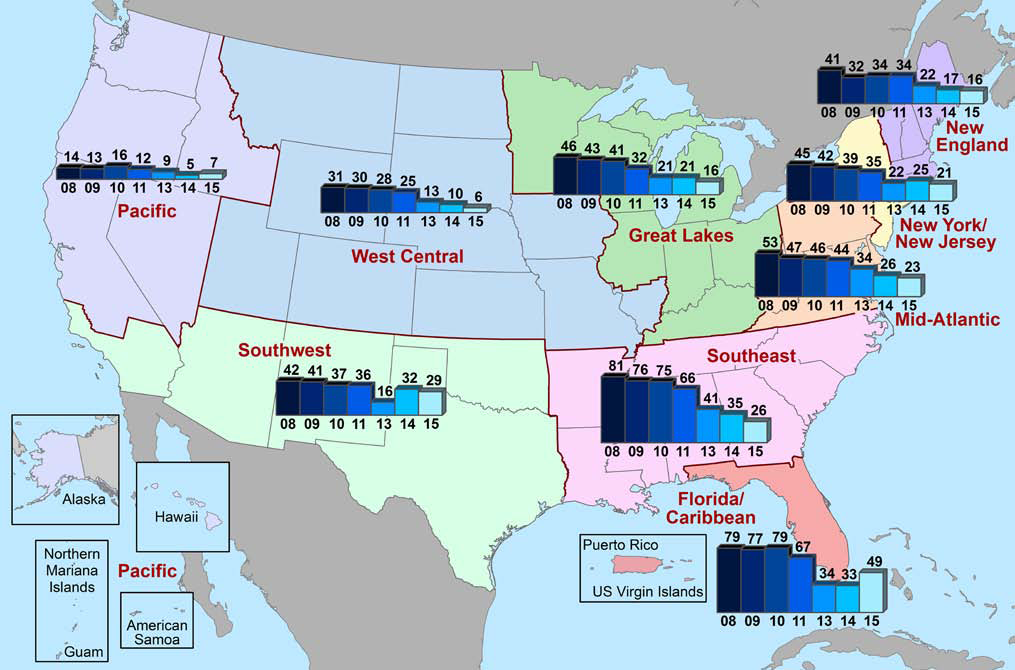
• Atlanta, Georgia: In 2014, cocaine availability continued to remain stable at both the retail and wholesale levels compared to 2013. During 2014, bulk cocaine seizure amounts in the DEA Atlanta FD AOR typically ranged between 1 and 25 kilograms.
• Chicago, Illinois: Cocaine is still readily available throughout the DEA Chicago FD AOR. Kilogram seizures of cocaine are becoming more routinely comingled with kilogram quantities of heroin and methamphetamine.
• Denver, Colorado: Although reporting during 2013 indicated that some distributors in the DEA Denver FD AOR experienced difficulty in obtaining consistent supplies of cocaine from sources in Mexico, cocaine availability and prices remained stable in 2014. Many distributors added adulterants to the drug to extend their supplies.
• New York City, New York: During 2014, cocaine remained readily available in the New York City area, which serves as an important distribution hub for East Coast markets.
• Philadelphia, Pennsylvania: During 2014, wholesale cocaine shipments consisting of multi-kilogram quantities originating from Arizona, California, and Texas dominated the local cocaine market.
• San Diego, California: Price, seizure, and investigative reporting suggest TCOs may be trafficking less cocaine in recent years than in the past, but wholesale and retail quantities of cocaine remain available in the San Diego area. Cocaine investigations and seizures often include at least one additional drug as well, typically methamphetamine.
• St. Louis, Missouri: DEA reporting indicates many traffickers consider retail quantities of cocaine are available, but of inferior quality. Several traffickers asserted that Mexican cartels, once primarily involved in cocaine distribution, have transitioned to other drugs such as crystal methamphetamine and heroin, claiming cocaine is “too hard to get.”
DEA’s Cocaine Signature Program (CSP) indicates that the vast majority of cocaine seized in US markets continues to be of Colombian origin. According to the CSP, of the 2014 samples analyzed to date, approximately 90 percent of cocaine tested was of Colombian origin, while approximately 10 percent was sourced to Peru, the highest percentage in at least a decade. In the past five years, Peruvian cocaine only comprised one to four percent of the CSP samples analyzed. However, available data on cultivation and cocaine yields indicate an increase in production from Colombia when compared to pre-2011 levels, which could impact cocaine availability in the United States.
(U) Map 10. Percentage of NDTS Respondents Reporting High Crack Cocaine Availability, 2008 – 2011, 2
013 – 2015
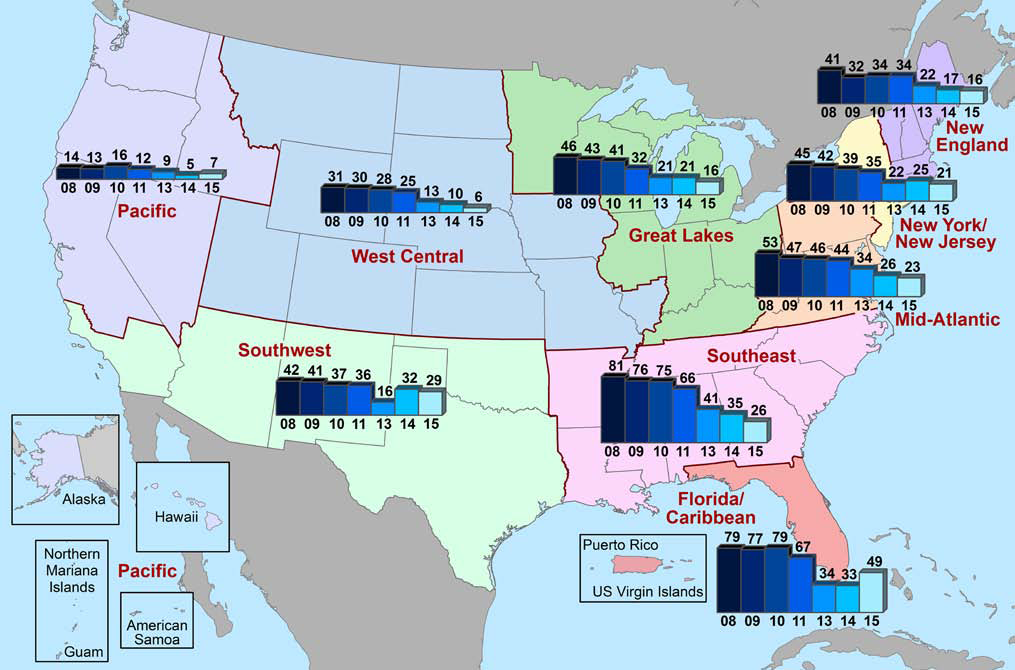
Methamphetamine as an Alternative to Cocaine
Consistently lower levels of cocaine available in the United States since 2007 forces distributors to increasingly cut cocaine in order for them to stretch supplies and meet demand. Distributors sell this less potent cocaine at higher prices in an effort to make up for lost profits. Cocaine distributors also compete against methamphetamine distributors, a drug which can serve as a cheaper and more potent alternative to cocaine.
• St. Louis, Missouri: Some African American cocaine trafficking organizations have transitioned to or expanded operations to include crystal methamphetamine distribution. These groups once primarily distributed cocaine and crack, but now supply large volumes of Mexican-produced crystal methamphetamine to the region. This development suggests traffickers are attempting to capitalize on geographical areas with an established high methamphetamine demand.
• Philadelphia, Pennsylvania: DEA investigative reporting indicates that Mexican organizations are pushing methamphetamine distribution on traditional cocaine trafficking organizations. [57]
• Atlanta, Georgia: According to DEA sources, traffickers experience periods in which they are temporarily unable to obtain cocaine from their respective sources of supply. During these times, traffickers will often supplement their revenue stream with methamphetamine sales.
Use Cocaine
Cocaine use has continued to decline since 2007 and mirrors the decline of cocaine availability in the United States. According to the 2013 NSDUH, there were an estimated 601,000 persons aged 12 or older who had used cocaine for the first time within the past 12 months. This number was similar to estimates reported from 2008 to 2012 (ranging from 623,000 to 724,000), but was significantly lower than estimates from 2002 to 2007 (ranging from 0.9 million to 1.0 million).
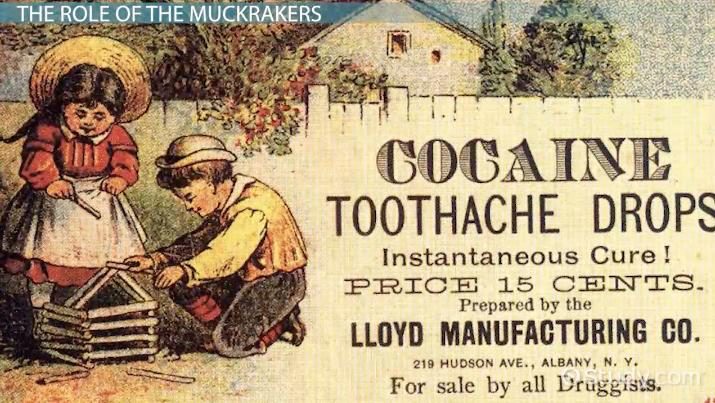
• According to NSDUH data in 2013, most (81.9 %) of the 0.6 million recent cocaine initiates were aged 18 or older when they first used cocaine. The average age at first use among recent initiates aged 12 to 49 was 20.4 years. The average age estimates have remained fairly stable since 2002.
• According to the 2014 MTF, about one in eight young adults aged approximately 13 to 18 years (12%) had tried cocaine, and 4.5 percent had tried it by their senior year of high school.
Cocaine
(U) DEA’s Cocaine Signature Program (CSP)
Each year, the DEA CSP determines the purity and origin of some 2,000 samples from domestic cocaine seizures made by US federal authorities and samples from a smaller number of foreign seizures made by international law enforcement agencies. CSP data is not intended to reflect US market share per se —as it is not based on a systematic random sampling of all cocaine seizures— rather, it provides a snapshot of overall trends in cocaine processing and cocaine flow from the analysis of samples from major seizures. However, the CSP provides a huge dataset (over 47,000 exhibits since 1998) for strategic intelligence analysis that reflects random cocaine samples taken from wholesale-level domestic seizures (submitted to all DEA laboratories) that total metric tons of cocaine each year. CSP analysis has consistently indicated that Colombian-origin cocaine dominates the market in the United States—accounting for over 90 percent of the cocaine analyzed (by weight and by the number of exhibits). These forensic findings are consistent with all available law enforcement intelligence and investigative reporting.
DEA Forensic Chemists employ various scientific methods to determine the geographic origin of the coca leaf used to make cocaine base. To “geo-source” the coca leaf is to “geo-source” the cocaine base as it is not practical to transport metric tons of coca leaf any significant distances (other DEA scientific studies have shown that nearly one metric ton of fresh coca leaf is required to produce one kilogram of cocaine base in Colombia.) It is for this reason that primitive cocaine base “labs” are typically located near coca fields in the cocaine source countries of Colombia, Peru, and Bolivia. Analysis of the trace solvents and chemicals/alkaloids found in the cocaine samples also provide insight into how and where the finished cocaine powder was produced. In addition, the CSP also analyzes cocaine samples for their wholesale purity level and the presence of bulking agents (such as table salt that has no pharmacological effects), adulterants (such as caffeine—a stimulant—that does have pharmacological effects), or enhancing agents (such as levamisole – thought to increase or prolong the effects of cocaine).
• Treatment data indicate the number of cocaine-related admissions (aged 12 and older) to publicly funded facilities declined from 13 percent in 2002 to 7 percent in 2012. (See Chart 25.)
(U) Chart 25. Cocaine-related Treatment Admissions, 2002 – 2012
Source: Treatment Episode Data Set
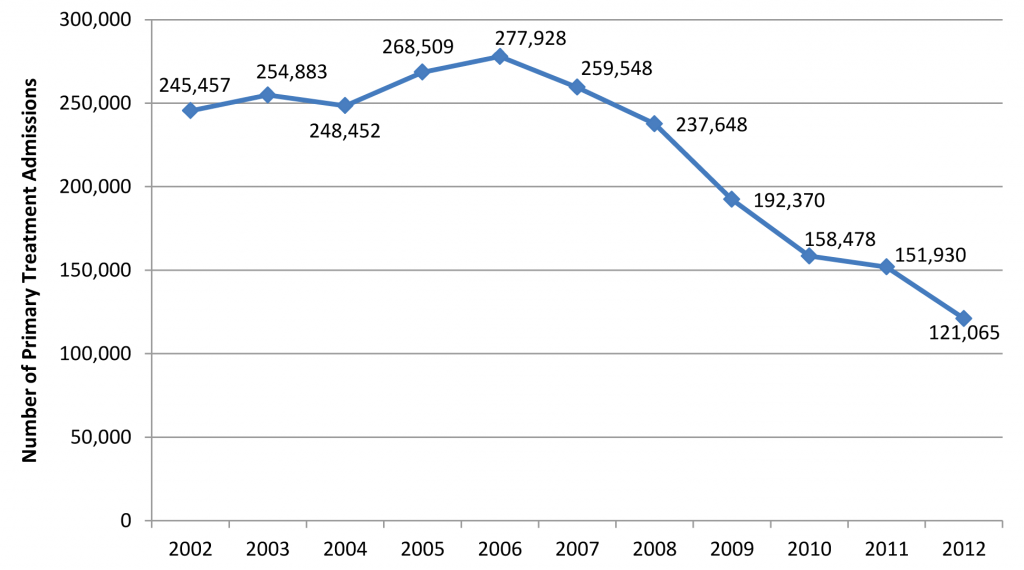
Smoked cocaine (crack) represented 69 percent of all primary cocaine admissions in 2012, down from 73 percent in 2002. The high proportion of cocaine admissions from crack is in contrast
UNCLASSIFIED
the use of crack is limited when compared to powder cocaine.
Cocaine contributes to a significant number of drug poisoning deaths in the United States, although the number of cocaine-related deaths has decreased concurrent with declines in availability and use; however, some areas still have high fatality rates. According to the CDC, there were 4,944 cocaine-related deaths in the United States in 2013. This was a 34 percent decline from 2006 (7,448 deaths). (See Chart 26.)
• According to post-mortem toxicology data provided by the Los Angeles County Department of the Coroner between 2005 and 2010, cocaine is the second-most commonly detected street drug in drug toxicity deaths in the Los Angeles area.
• According to the San Diego County ME 2013 Annual Report, cocaine caused 40 unintentional deaths in 2013, up from 34 in 2012.
• Virginia Poison Control statistics for the Virginia area within the Washington, DC Metropolitan area reported 131 cocaine-related incidents for 2013, which reflects a 62 percent increase compared to the 81 incidents reported for 2012.
(U) Chart 26. Drug Poisoning Deaths Involving Cocaine, 1999 – 2013 Source: National Center for Health Statistics/Centers for Disease Control, Final death data for each calendar year
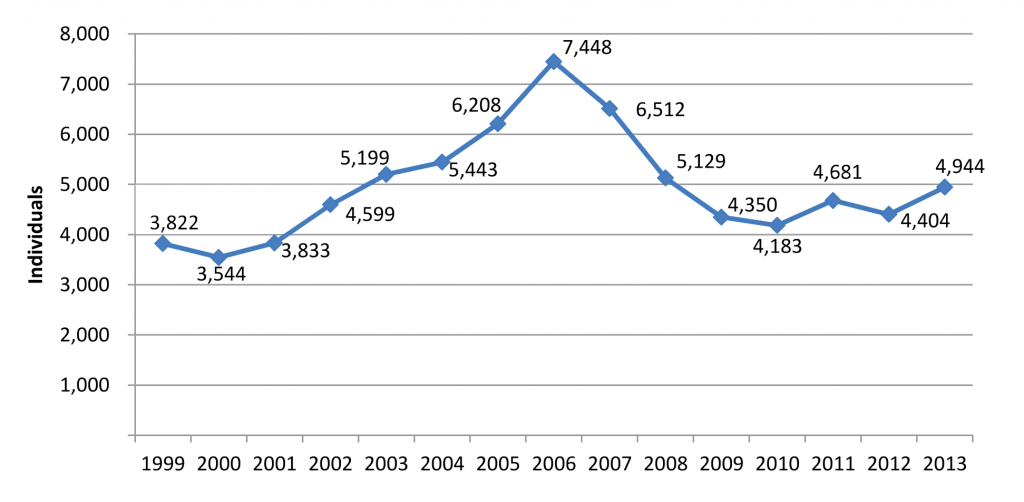
Production [Cocaine]
Most of the cocaine available in the United States is Colombia-produced; however, according to US Government estimates, Peru remains the top producer of export quality cocaine followed by Colombia with the majority of Peruvian cocaine transported to European or Asian markets. US Government cocaine production estimates indicate a 30 percent increase in potential pure cocaine production in Colombia between 2013 and 2014, from 185 metric tons to 245 metric tons. Potential pure cocaine production in Peru also increased between 2013 and 2014, from an estimated 265 metric tons to 285 metric tons.
DEA’s Breakthrough Program provides unique insight when assessing cocaine production capabilities in Colombia, Peru, and Bolivia, the three Andean Region cocaine source countries. The program found that the production potential of Colombia trails behind both Peru and Bolivia on a per hectare basis. On a national average, the [59]
amount of pure cocaine that can be produced per hectare per year in Peru and Bolivia is significantly higher than the amount of pure cocaine generated per hectare per year in Colombia.
The higher yields and increase in Peruvian production impacts US cocaine availability far less than Colombian production estimates because CSP data indicates Peruvian-sourced cocaine accounts for a small proportion—approximately 10 percent—of the cocaine available in the United States. Colombian TCOs dominate the cocaine supply to the United States due to their experience and longstanding working relationships with Caribbean, Central American, and Mexican traffickers. Cocaine traffickers in Peru lack such a historical link to the US market. Further, higher cocaine prices in other parts of the world present a strong incentive for Peruvian traffickers to establish other markets rather than compete with Colombian TCOs for the US market.
Mexican TCOs also appear to be smuggling cocaine base to Mexico for finished conversion to powder cocaine there, possibly in an effort to increase their participation in the cocaine production process.
• Peru: In February 2014, Peruvian officials seized approximately 75 kilograms of cocaine base concealed within 160 large sacks of garlic from a container in Callao, Peru, that were to be exported to Mexico.
• Colombia: In January 2014, Colombian authorities intercepted 490 kilograms of cocaine base from a Mexico-bound Cessna aircraft at Ipiales airport in the Nariño Province.
• Peru: In January 2014, Peruvian officials seized 273 kilograms of cocaine base concealed inside 400 sheets of plywood. The shipping documents indicated the container was to be shipped from the Port of Callao in Lima to the Port of Mazatlán in Mexico.
Transportation [Cocaine]
The majority of cocaine destined for US markets is transported across the Southwest Border via Mexico in kilogram quantities. After the cocaine is smuggled across the US–Mexico Border, it is moved to major hub cities in Arizona, California, and Texas near the Southwest Border. The cocaine is then transported via interstate highways to the Midwest and East Coast, to include major hub cities such as Atlanta, Chicago, and New York.
(U) Map 11. 2014 – Change in Cocaine Trafficking in the CBP Corridors Source: DEA and US Customs and Border Protection
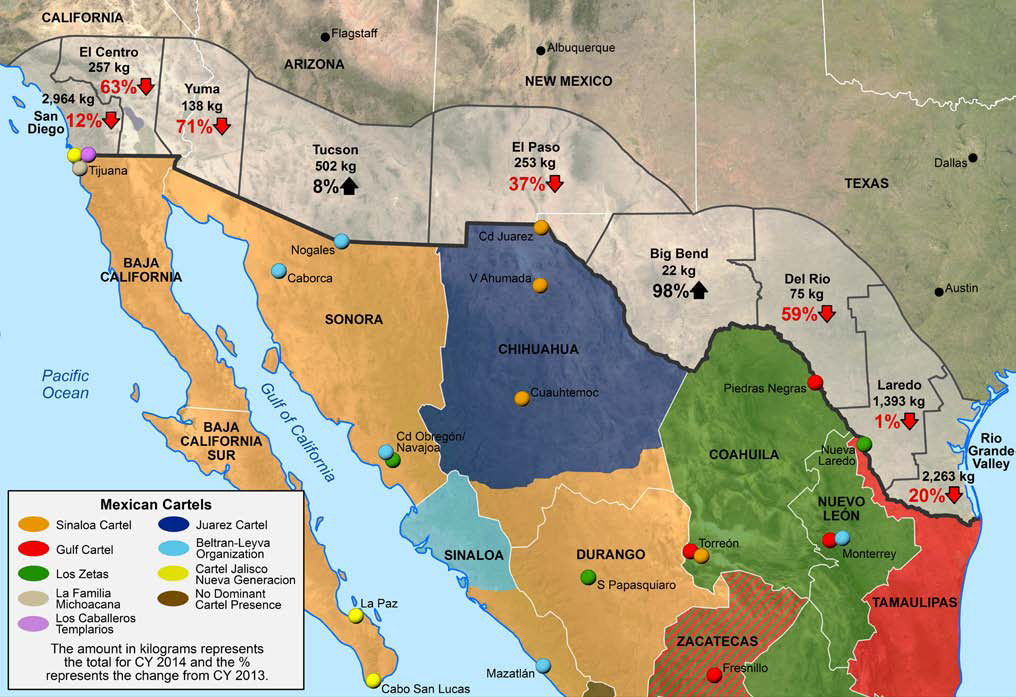
• The majority of the cocaine seized at the Southwest Border is interdicted in California (San Diego sector) and South Texas (Laredo and Rio Grande Valley sectors). In 2014, cocaine seizures at the Southwest Border continued to decline from the previous year. (See Map 11.)
Cocaine is also transported through the Caribbean corridor to the East Coast of the United States. An estimated 13 percent of cocaine flow into the US transit zone was through the Caribbean corridor, while most—87 percent—was transferred via the Mexico/Central America corridor. In 2014, over 90 metric tons was moved from South America to the Caribbean corridor, primarily toward the Dominican Republic and Puerto Rico via go-fast boats. [Cocaine]
In some instances cocaine is also transported directly from South American source countries to the United States via containerized cargo and couriers on commercial flights. South American cocaine traffickers exploit the large volume of containerized cargo used in international trade to smuggle cocaine to the United States. This method is successful due to corrupt officials in South American ports and the logistical impossibility of inspecting all containerized cargo. In addition, couriers on commercial flights smuggle small amounts of cocaine. DEA reporting indicates instances of courier smuggling from Guyana to New York (See Table 10).
Cocaine trafficking organizations use an array of methods to transport cocaine throughout the United States. Tractor trailers and passenger vehicles are frequently used to transport multi-kilogram quantities of cocaine. Cocaine is hidden amongst legitimate cargo or secreted inside of intricate hidden compartments built within passenger vehicles.
61
• Norfolk, Virginia: In December 2013, CBP seized 332 kilograms of cocaine concealed inside cans of juice in Norfolk, Virginia, from a cargo container which originated in Trinidad and Tobago.
• Fort Myers, Florida: In August 2014, the DEA Fort Myers RO seized a package from Buenos Aires, Argentina, containing a spiral binder of twelve sheets of paper impregnated with cocaine.
• New York: New York Organized Crime Drug Enforcement Strike Force reporting indicates that cocaine is smuggled into the United States via business-sized envelopes carried by passengers aboard cruise ships.
• Riverside, California: In April 2015, DEA and the San Bernardino County Sheriff’s Office seized 20 kilograms of cocaine concealed in a hidden compartment in the rear seat of a passenger vehicle.
Mexican TCOs continue to dominate cocaine transportation in the United States. In the past, Colombian organizations controlled a wider cocaine transportation network, but are now operating in only a small number of locations along the East Coast. Major Mexican TCOs rely on associated US-based organizations or independent third parties to transport cocaine to their distribution cells. At the present time there appear to be no other criminal groups that possess the requisite power to challenge Mexican TCO dominance of cocaine transportation in the United States.
(U) Table 10. Cocaine Seizures with Direct Links Between Guyana and New York Source: DEA Reporting. Unless noted, all seizures occurred at the Cheddi Jagan International Airport on flights destined to JFK.276 DATE SEIZURE DETAILS
October 2013 3.36 kg Concealed in undergarments
November 2013 2.93 kg Hidden in false wall of suitcase
January 2014 15.30 kg Hidden in suitcase
January 2014 4.05 kg Seized at JFK, concealed in handbags
February 2014 10 .00 kg Hidden in produce
February 2014 13.39 kg Seized at JFK, concealed in checked luggage
April 2014 7.05 kg Concealed in baked goods
Distribution [Cocaine]
The distribution of cocaine at the retail-level is typically carried out by local US criminal groups and street gangs of varying ethnic origins. Mexican TCOs are not as involved in retail-level distribution in the United States, as they actively seek to limit attention from US law enforcement and focus on wholesale quantity transportation. Colombian and Dominican trafficking organizations still participate in cocaine distribution along the East Coast as well, but on a limited scale in comparison to previous years.
• Boston, Massachusetts: Colombian and Dominican trafficking organizations have historically dominated the importation and wholesale distribution of cocaine throughout the New England states. However, many of these groups are increasingly dealing with and receiving cocaine directly from Mexican TCOs based in Arizona, California, Texas, and even Mexico.
• Newark, New Jersey: Recent reporting indicates local Mexican criminal organizations are increasing involvement in wholesale cocaine distribution. However, cocaine distribution is generally organized in a hierarchy based on nationality. Colombian TCOs, historically, controlled wholesale distribution of cocaine in the New Jersey area, while Dominican groups handled retail distribution for Colombian groups. The Dominican groups typically supplied African American street gangs, who handled street
[62] level distribution. While Dominican groups work with Colombian TCOs, they also operate independent of each other.
• New York City, New York: Colombia-based distributors continue to supply New York City’s distribution networks, dominated by Dominican trafficking organizations. Colombian drug traffickers regularly smuggle multi-hundred kilogram shipments of cocaine to New York City. New York City-based cocaine distribution organizations also serve as the source of supply to organizations operating throughout the eastern United States. Mexican TCOs are also involved in local wholesale level distribution.
• Philadelphia, Pennsylvania: Dominican trafficking organizations engage in wholesale and retail level cocaine distribution and to a lesser extent are also involved in cocaine transportation.
Outlook [Cocaine]
Cocaine availability will remain stable in the near term at “new normal” levels. With the high availability of less costly methamphetamine, which serves as a cocaine alternative in areas such as the Midwest, it is unlikely that cocaine levels will return to pre-2007 levels in the near term.
Mexican TCOs will continue to dominate the transportation of cocaine throughout the United States as evidenced by the significant percentage of the cocaine available in the United States that transits the Mexico/Central America corridor. Further, at the present time no other TCOs control enough of the drug trafficking infrastructure to challenge Mexican TCOs.
Colombian cocaine will continue to dominate the US market in the near term despite higher levels of production in Peru. This is due to the historic working relationship between Colombian cocaine producers and Mexican TCOs.
UNCLASSIFIED
Cocaine
Disclaimer: The author of each article published on this web site owns his or her own words. The opinions, beliefs and viewpoints expressed by the various authors and forum participants on this site do not necessarily reflect the opinions, beliefs and viewpoints of Utah Standard News or official policies of the USN and may actually reflect positions that USN actively opposes. No claim in public domain or fair use. © Edmunds Tucker. UTopiAH are trade marks of the author. Utopia was written in 1515 by Sir Thomas More, Chancellor of England.
[2015 Drug Threat Assessment continues next at Part 85 Marijuana]
Utah Standard News depends on the support of readers like you.
Good Journalism requires time, expertise, passion and money. We know you appreciate the coverage here. Please help us to continue as an alternative news website by becoming a subscriber or making a donation. To learn more about our subscription options or make a donation, click here.
To Advertise on UtahStandardNews.com, please contact us at: ed@utahstandardnews.com.


Comments - No Responses to “Part 84 United States Drug Enforcement Administration Releases 2015 National Drug Threat Assessment Summary Cocaine, 4,944 cocaine related deaths, Mexican, Columbian, Peruvian, smuggling, crime. DEA ICE FDA”
Sure is empty down here...